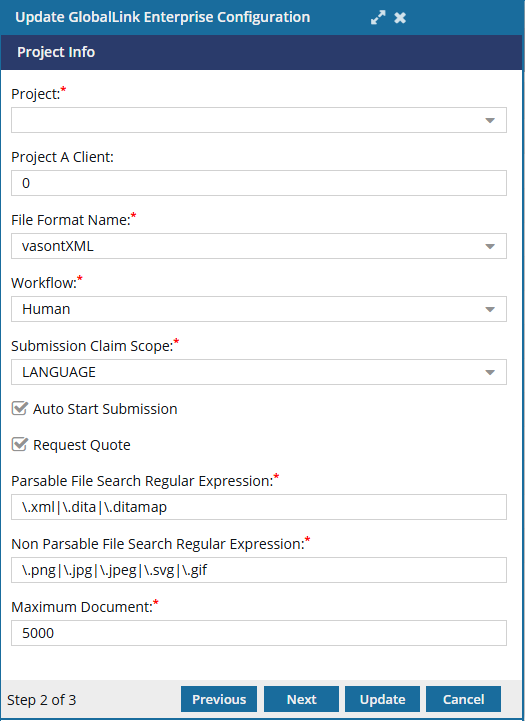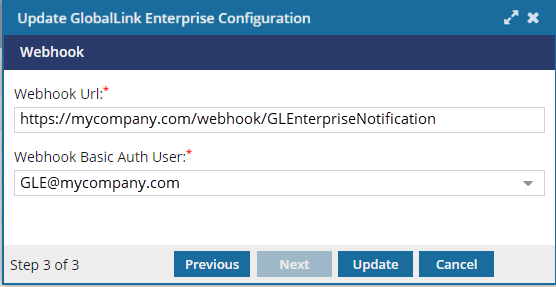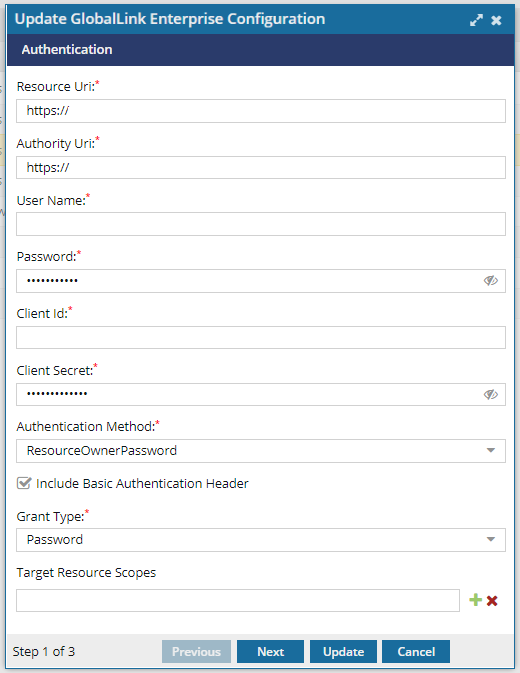Edit the configuration information
After you create an Active translation integration method called GlobalLink Rest Apis, and you authenticate your method with GlobalLink Enterprise (formerly known as Project Director), you can see and edit the Configuration Information. When editing a configuration, you use the three-page wizard to specify all your integration details.
 Tips and tricks:
Tips and tricks:
 You must be an Administrator to work with translation integration methods.
You must be an Administrator to work with translation integration methods.- Project Director has been renamed to GlobalLink Enterprise.
- Before you can click Edit Configuration, you must Authenticate an API translation integration.
- If you want to update a Translation Integration method just to enable the use of quotes, follow the steps in: Configure a PD Rest Integration Method for quotes.

To edit a translation integration method's Configuration Information:
Add Authentication parameters
Integration configuration basically allows Inspire to communicate with third party services, such as GlobalLink Enterprise.

 Before you begin
Before you begin
- To avoid unauthenticated access, there should be an authentication mechanism used.
- You must get the authentication details such as Client ID and Secret, from your service provider.


To add Authentication parameters:
Add Project Information
On the Project Info (Step 2 of 3) screen, you must add details about the Project you've created in GlobalLink Enterprise to work with translation jobs coming from Inspire.
 The options available on this screen are configured in your GlobalLink Enterprise project. If you don't see an option you need, you will need to sign into GlobalLink Enterprise and re-configure your project.
The options available on this screen are configured in your GlobalLink Enterprise project. If you don't see an option you need, you will need to sign into GlobalLink Enterprise and re-configure your project.



To add project Information:
Configure the webhook
A webhook (also called a web callback or HTTP push API) is a way for GlobalLink Enterprise to provide Inspire with real-time information. A webhook delivers data as it happens, so you can see the status of a translation job in GlobalLink Enterprise immediately.

 Before you begin
Before you begin
- The webhook information is unique to your company's connection with GlobalLink Enterprise.
- If you use values that aren't correct, Inspire won't be able to communicate with GlobalLink Enterprise.
- You must acquire the details, such as URL and Auth User, from the service provider.
- If you aren't sure what to use, contact your Vasont account manager or support by email at: GlobalLinkCCMS-Support@TransPerfect.com.



- In Webhook Url, enter the name of your company's GlobalLink Enterprise instance, followed by webhook/GlobalLink EnterpriseNotification.
- In Webhook Basic Auth User, select a user who has access to your company's GlobalLink Enterprise instance.
- On the Webhook screen, click Update.


 Result: You see the
Result: You see the 
 To verify you entered the correct password, you can show the characters by clicking
To verify you entered the correct password, you can show the characters by clicking